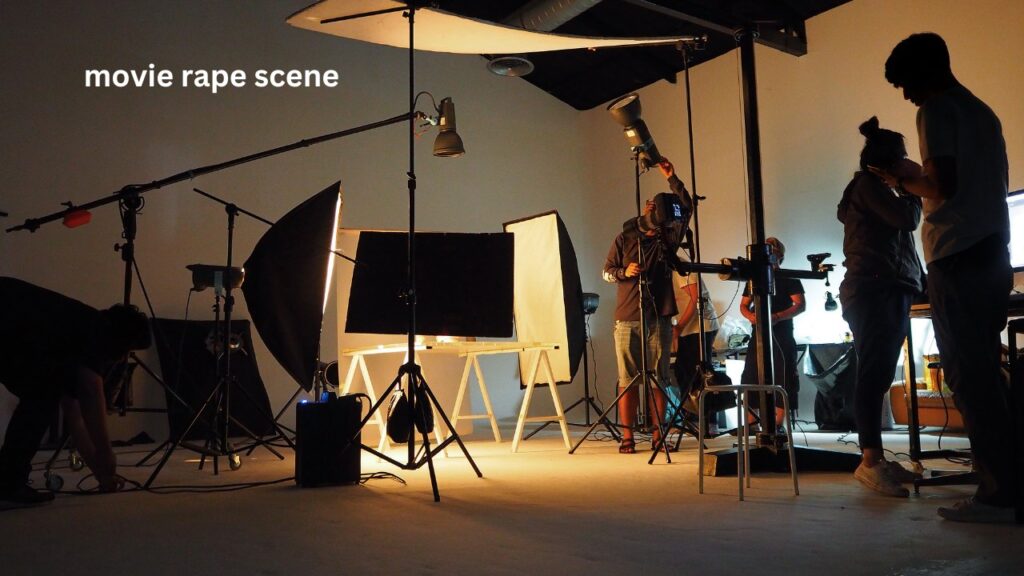Movie rape scene are among the most contentious and sensitive subjects in the realm of filmmaking. These scenes can evoke intense emotional reactions, provoke critical discussions, and impact viewers profoundly. This article delves into the historical context, ethical considerations, representation in media, impact on audiences, and the role of rape scenes in storytelling. By examining these aspects, we aim to provide a comprehensive understanding of this complex issue.
Early Depictions of Movie Rape Scene in Cinema
The portrayal of rape in cinema dates back to the early days of film. Initially, these movie raping scenes were often implicit, relying on suggestion rather than explicit depiction. Films from the silent era and early talkies rarely included direct portrayals of sexual violence, instead using implied threats or off-screen events to convey the gravity of the act. This approach was partly due to the prevailing social norms and censorship standards of the time.
Evolution of Portrayal Over the Decades
As cinema evolved, so did the portrayal of rape. The latter half of the 20th century saw more explicit and graphic depictions, often used to shock or provoke audiences. Films like “A Clockwork Orange” (1971) and “The Accused” (1988) brought rape scenes to the forefront, sparking debates about their necessity and impact. These Movie Rape Scene began to be scrutinized not only for their content but also for the context in which they were presented.
The Responsibility of Filmmakers
Filmmakers have a significant responsibility when depicting movie raping scenes. They must balance the need for authenticity with sensitivity to the subject matter. The portrayal should serve a narrative purpose and not be gratuitous or exploitative. Directors and writers must consider the potential impact on survivors of sexual violence and the broader audience. The ethical responsibility extends to ensuring that these Movie Rape Scene are handled with care and respect.
Consent and Actor Welfare
The welfare of actors involved in Movie Rape Scene is paramount. It is crucial to obtain explicit consent from actors and to provide them with the necessary support and resources. Filmmakers often employ intimacy coordinators to choreograph such scenes, ensuring that actors feel safe and comfortable. Open communication and a supportive environment are essential to navigate the complexities of filming sensitive content.
Accuracy and Sensitivity
Accurate and sensitive portrayal of rape is vital in media representation. Filmmakers should strive to depict the realities of sexual violence without perpetuating harmful myths or stereotypes. This includes avoiding sensationalism and instead focusing on the emotional and psychological aftermath for the victim. A nuanced portrayal can help educate audiences and foster empathy and understanding.
Stereotypes and Misrepresentations
Unfortunately, many films perpetuate stereotypes and misrepresentations of rape. These can include portraying rape as a plot device to advance a male character’s storyline or depicting victims in a way that reinforces victim-blaming attitudes. Such portrayals can contribute to societal misconceptions about rape and undermine the experiences of survivors. It is crucial for filmmakers to challenge these stereotypes and strive for more accurate and respectful depictions.
Psychological Effects
The psychological effects of viewing movie raping scenes can be profound. For survivors of sexual violence, these Movie Rape Scene can be triggering and retraumatizing. Even for those without personal experience, the depiction of such violence can evoke strong emotional reactions. Filmmakers must be mindful of these potential effects and consider the inclusion of trigger warnings to inform viewers of sensitive content.
Trigger Warnings and Viewer Discretion
Trigger warnings and viewer discretion advisories play a crucial role in preparing audiences for potentially distressing content. These warnings provide viewers with the information they need to make informed decisions about their viewing choices. Including trigger warnings demonstrates a commitment to audience welfare and acknowledges the impact that such scenes can have on individuals.
Narrative Purpose
The inclusion of rape scenes in a film should serve a clear narrative purpose. These scenes should contribute to character development, plot progression, or thematic exploration. When handled thoughtfully, the depiction of rape can highlight important issues, provoke critical discussions, and drive home the severity of sexual violence. However, if the scene is gratuitous or unnecessary, it risks diminishing the narrative’s integrity and offending viewers.
Alternatives to Explicit Depictions
Filmmakers can explore alternatives to explicit depictions of rape. Implied or off-screen portrayals can be equally powerful and respectful of the subject matter. Creative storytelling techniques, such as focusing on the aftermath or using symbolic imagery, can convey the gravity of the event without resorting to graphic visuals. These approaches allow for meaningful exploration of the issue while minimizing potential harm to the audience.
Notable Films and Their Approaches
Several films have approached rape scenes with varying degrees of sensitivity and impact. “The Accused” (1988) is often cited for its raw and unflinching portrayal, which sparked significant discussion and led to increased awareness about sexual violence. “Boys Don’t Cry” (1999) and “The Girl with the Dragon Tattoo” (2011) also addressed rape with a focus on the victim’s perspective and the broader social implications. These films illustrate different methods of handling such difficult content.
Controversial Scenes and Public Reaction
Some movie raping scenes have generated significant controversy and public backlash. “Irreversible” (2002) is infamous for its graphic and prolonged depiction, which many critics deemed excessive and exploitative. The intense reactions to such scenes underscore the importance of thoughtful and respectful portrayal. Controversial scenes often ignite debates about artistic freedom versus ethical responsibility, highlighting the delicate balance filmmakers must maintain.
Insights from Filmmakers
Directors and writers who tackle movie raping scenes often share insights into their creative processes and ethical considerations. Many emphasize the importance of extensive research, consultation with experts, and collaboration with actors. Filmmakers like Lisa Cholodenko (“The Kids Are All Right”) and Emerald Fennell (“Promising Young Woman”) have spoken about their approaches to handling sensitive content, offering valuable perspectives on the challenges and responsibilities involved.
Actor Experiences and Challenges
Actors who portray movie raping scenes face unique challenges and emotional tolls. Their experiences can vary widely, depending on the support and resources provided by the production team. Some actors find the process cathartic and empowering, while others may struggle with the emotional aftermath. Open dialogue, professional support, and a respectful working environment are crucial for navigating these challenges.
Critical Reception
The critical reception of rape scenes often hinges on their context and execution. Thoughtfully portrayed scenes that contribute to the narrative and raise awareness are generally well-received. In contrast, gratuitous or exploitative depictions tend to attract criticism and backlash. Critics play a vital role in shaping public discourse and holding filmmakers accountable for their portrayals of sensitive content.
Viewer Feedback and Discussions
Viewer feedback and discussions about rape scenes can provide valuable insights into their impact. Online forums, social media, and film reviews offer platforms for audiences to share their reactions and engage in critical dialogue. These discussions can highlight diverse perspectives, identify potential harms, and advocate for more responsible and respectful portrayals in the future.
Influence on Public Perception
The portrayal of rape in movies can significantly influence public perception and understanding of sexual violence. Thoughtful and accurate depictions can raise awareness, challenge harmful myths, and foster empathy. Conversely, irresponsible portrayals can perpetuate misconceptions and contribute to a culture of victim-blaming. Filmmakers have the power to shape societal attitudes and must wield this influence responsibly.
Role in Awareness and Advocacy
Movies that address rape can play a crucial role in awareness and advocacy. Films like “The Hunting Ground” (2015) and “Spotlight” (2015) have shed light on institutional failures and sparked real-world change. By highlighting issues and amplifying survivor voices, go movies sx can contribute to broader movements for justice and reform. This advocacy can extend beyond the screen, inspiring audiences to take action and support survivors.
Best Practices for Depicting Sensitive Content
Filmmakers can follow best practices to ensure respectful and responsible portrayal of rape scenes. These include thorough research, collaboration with experts, and obtaining informed consent from actors. Prioritizing the welfare of cast and crew, providing trigger warnings, and considering alternatives to explicit depictions are also essential steps. By adhering to these practices, filmmakers can navigate the complexities of sensitive content with care and integrity.
Collaborating with Experts
Collaboration with experts, such as trauma counselors and advocacy organizations, can enhance the accuracy and sensitivity of rape scenes. These professionals can provide valuable insights into the experiences of survivors, the psychological impact of sexual violence, and effective ways to portray these realities on screen. Their involvement ensures that the depiction is grounded in real-world knowledge and aligns with best practices for ethical filmmaking.
The Future of Rape Scenes in Movies
The future of rape scenes in go movies sx will likely be shaped by ongoing discussions about ethics, representation, and audience impact. As societal awareness of sexual violence grows, so does the expectation for thoughtful and respectful portrayal. Filmmakers must continue to innovate and adapt, finding new ways to address this difficult subject with sensitivity and care. By doing so, they can contribute to a more informed and empathetic society.
Also Read: Wifey vs The Cannon: The Epic Showdown
Common Questions about Movie Rape Scenes
Why are rape scenes included in movies?
Rape scenes are included in movies to address important social issues, contribute to character development, or advance the narrative. However, their inclusion must be handled with sensitivity and purpose.
How can filmmakers ensure the respectful portrayal of rape scenes?
Filmmakers can ensure respectful portrayal by conducting thorough research, collaborating with experts, obtaining informed consent from actors, and prioritizing their welfare.
What impact do rape scenes have on audiences?
Rape scenes can have a profound impact on audiences, including triggering emotional reactions and influencing perceptions of sexual violence. Trigger warnings and viewer discretion advisories are essential.
What alternatives exist to explicit depictions of rape?
Alternatives to explicit depictions include implied or off-screen portrayals, symbolic imagery, and focusing on the aftermath of the event. These approaches can convey the gravity of the act without graphic visuals.
How have notable films approached rape scenes?
Notable films have approached rape scenes with varying degrees of sensitivity. Examples include “The Accused” for its raw portrayal and “Spotlight” for its focus on institutional failure.
What role do movies play in raising awareness about sexual violence?
Movies can raise awareness by highlighting issues, challenging myths, and amplifying survivor voices. Thoughtful portrayals can contribute to broader movements for justice and reform.



